●秋の演能 10月11日(祝日)午前10時より
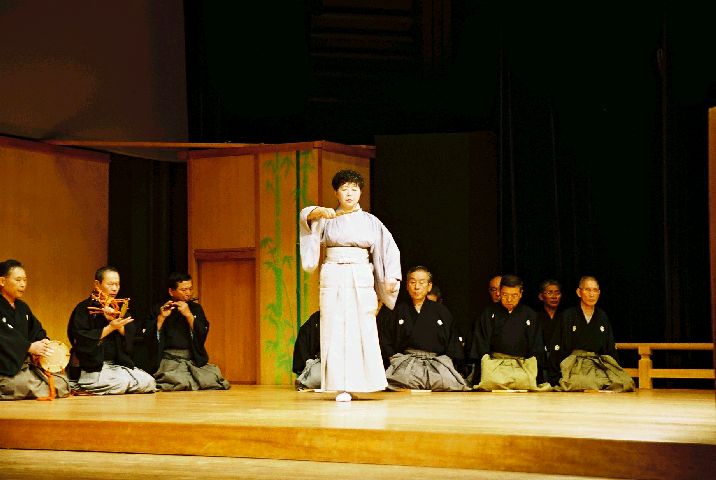
舞囃子 「東北」 シテ 浜崎幸子 大鼓 平山昇 小鼓 山田風月 笛 岩淵健一
地謡 相良 実 鈴木 圭介 星 英男 渡部藤之丞 稲村忠兵エ 松川善之助 佐藤昌一 佐藤信英
半能 「玉葛」tam akaz ura
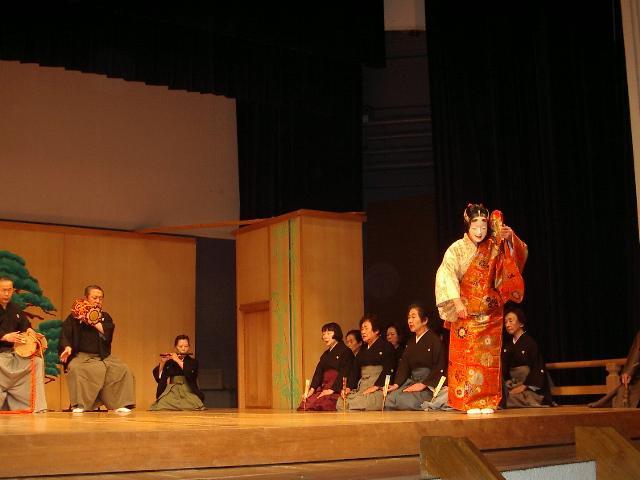
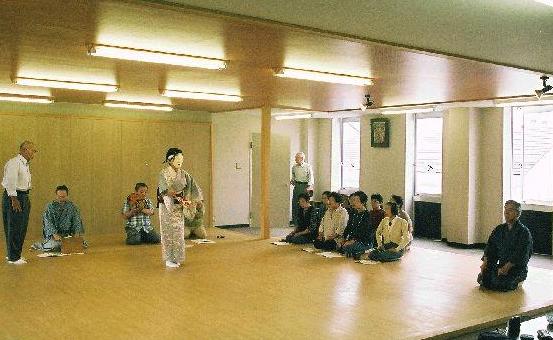
シテ 野崎邦子 ワキ 上野正義
大鼓 山田風月 小鼓 折笠成美 笛 五十嵐弘子
地謡 金川照子 古田豊子 渡部妙子 石田セツ子 山田ミヤ子
五十嵐常子 瓜生光子 佐藤ヨシカ 玉川おくに 志波幸世
後見 丑米義弘 丸山一郎
平成16年(2004)の行事の報告
●秋の演能 10月11日(祝日)午前10時より

舞囃子 「東北」 シテ 浜崎幸子 大鼓 平山昇 小鼓 山田風月 笛 岩淵健一
地謡 相良 実 鈴木 圭介 星 英男 渡部藤之丞 稲村忠兵エ 松川善之助 佐藤昌一 佐藤信英
半能 「玉葛」tam akaz
ura


シテ 野崎邦子 ワキ 上野正義
大鼓 山田風月 小鼓 折笠成美 笛 五十嵐弘子
地謡 金川照子 古田豊子 渡部妙子 石田セツ子 山田ミヤ子
五十嵐常子 瓜生光子 佐藤ヨシカ 玉川おくに 志波幸世
後見 丑米義弘 丸山一郎
●玉葛
能「玉葛」は『源氏物語』にちなむ曲です。諸国一見の僧が奈良の都の社寺を巡礼し、こもりくの初瀬の長谷観音へ詣でます。初瀬川の川辺に来ると、山川の岩間伝いに小舟に棹を差して漕いでくる女に出会います。僧が不審に思い言葉をかけると、女は自分も長谷寺に参詣するのだが、古歌に「海士小舟初瀬の川」と読まれているから女が小舟を漕ぐのも不思議であるまいと言います。女は僧を二本の杉に案内し、源氏物語に、玉葛内侍が筑紫の国から都に逃げ上り、初瀬に来たところ、母の夕顔に仕えていた侍女右近に巡り会ったことなどを語り、自分はその玉葛の亡霊であるとほのめかして、姿を消します。
僧は哀れに思って、読経をしていると、玉葛の亡霊が現れ、恋の妄執に狂いますが、やがて昔の事を懺悔し、妄執を晴らし成仏を得て姿を消します。今回は、「半能」と言って、能の後半の部分を演じます。狂いを表す「カケリ」という舞が舞われます。
●Story of Tamakazura
A priest who is going on a pilgrimage to the
shrine and temple in Nara arrives
at the riverbank of Hatuse in order to worship Kannon Hase. He
notices a young
woman who rows and goes down a boat along a rock.
The woman answers to the question of the priest "I am going
to worship at Hase temple like you go"
And she shows him to the place of two Japan cedars currently read
by an old poem.
Then, she says as follows. When Tamakazura of Genjimonogatari(Genji-tales)
came to Hatsuse, she encountered the lady's maid Ukon who had
served Mother Yuugao.
She hints that she is a ghost of Tamakazura, and disappears. While
reciting sutras by the priest of regarding her as sad, a ghost
of Tamakazura appears.
For a while, although a woman is in agony and is troubled with
delusion of love, by sutra recitation of the priest, she dispels
delusion and disappears.
When the priest awakes out of a dream, it is beginning to become
bright unawares.
He notices that the encounter with the woman was a dreamy occurrence.
Since the portion of the second half is performed, this Noh is
said half Noh.
The leading role's Tamakazura dances dancing called kakeri showing
deviation.
Thus, she expresses her joy by showing the beautiful dance and
disappears into the mist at daybreak.
舞囃子 「唐船」
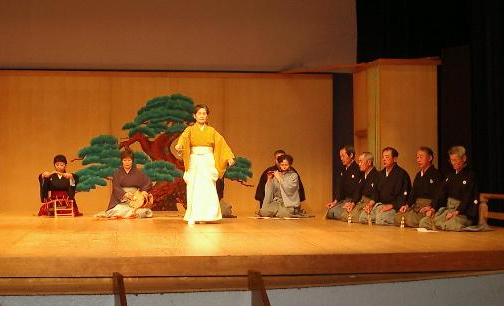
シテ 松枝千代子 大鼓 角田久美子 小鼓 折笠成美 太鼓 佐藤 馨 笛 堀 篤子
地謡 小林 忠 長沼常哲 湯田真佐弘 河合真弘 庄條静雄
能 「須磨源氏」
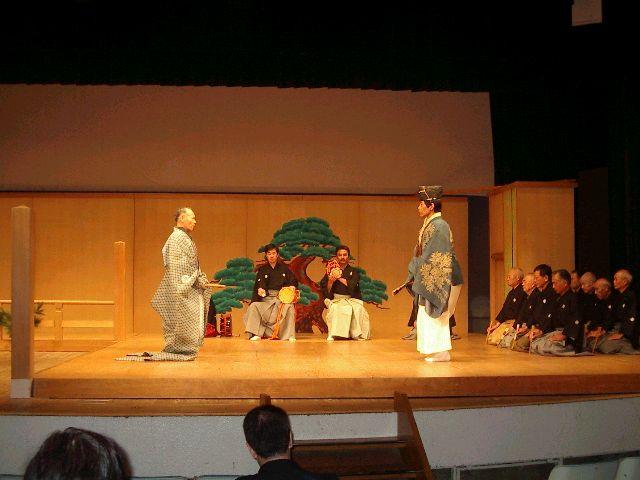
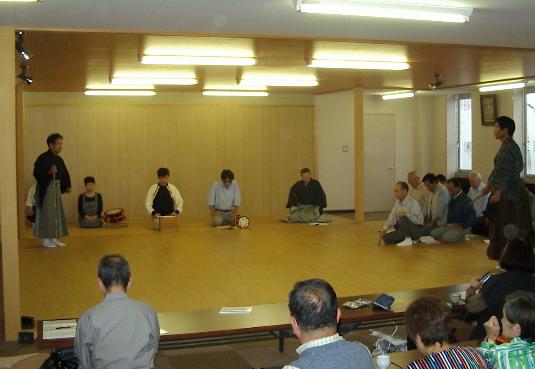
写真上右はワキとワキツレ 後シテの登場場面の申し合わせ(予行演習)
写真下、光源氏が須磨の浦に現われ舞う場面、面の表情が見る角度で変化する。
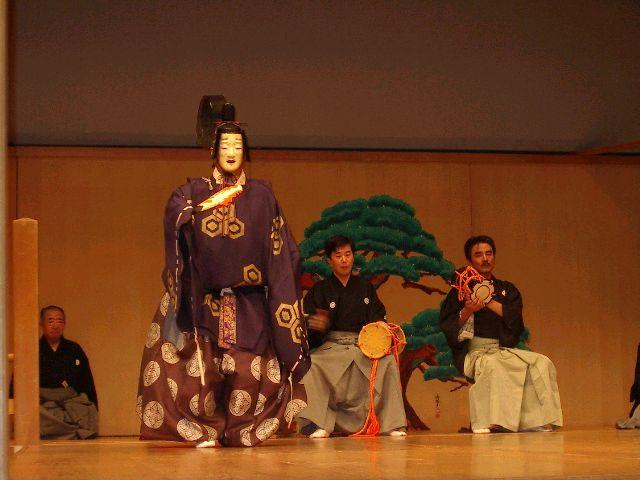
前シテ 伊東正 後シテ 坂内庄一 ワキ 一条正夫 ワキヅレ 皆川米作
大鼓 舟木真一 小鼓 阿部晃司 太鼓 佐藤 馨 笛 山田和彦
地謡 角田喜久雄 有我嘉雄 佐野健一
平山 昇 中村寿男 針生 博 平林光雄
後見 松川善之助 岸栄一郎 小野木 保 装束方 丸山美伊子 佐藤ヨネ 小野木和子 岸栄一郎 森田ルリ子ほか
●須磨源氏
能「須磨源氏」は『源氏物語』にちなむ曲です。日向の国の宮崎の社官藤原興範(ワキ)が、伊勢参宮を志し、今須磨の浦に着きますと、樵の老人が桜を眺めているので、この花は由緒のある木かと尋ねます。老人はこれこそ名に負う「若木の桜」であると答え、社官に問われるままに、光源氏の生涯を語り、自分こそ『源氏物語』の主人公光源氏であると告げて雲に隠れます。
社官が光源氏ゆかりの須磨の浦で奇特を拝もうと待っていると、音楽が聞こえ、月光の輝く浦に、光源氏の霊が天下り、青海波の舞(盤渉早舞)を美しく舞い、夜明けと共に天に戻って行きます。
●Sumagenji
Fujiwara Okinori who is the Shinto priest of Miyazaki country goes to worship of the Isejinnguu shrine. He arrives at the seashore of Suma. Since the one old man is looking at the cherry tree, he asks the old man whether this flower is a storied tree. Then, the old man answers that this is just the cherry tree of famous Wakaki. The old man tells the whole life of Hikarugenji as he is asked by the Shinto priest. Since this neighborhood is the place which was the home of Hikarugenji, Hikarugenji will go down from heavens and will appear on the sea with the light of the moon。 The old man announces that really he is Hikarugenji of the Tale of Genji, and hides in clouds this evening.
Okinori wants to worship the wonderful phenomenone.
He takes a nap and is waiting for it on the seashore of a moonlight
night. Then, it is indistinguishable from the sound of a wave,
music can be heard, and the soul of Hikarugenji gets down from
heavens to the seashore where moonlight shines. He dances dancing
of Seikaiha beautifully, and returns to heavens with dawn.
素謡 7 番 ( )内はグループ名
志賀(宝円会) 鵺(能楽会B) 紅葉狩(みやび会) 忠度(能楽会A)
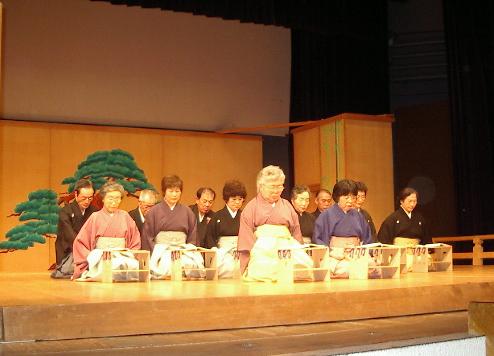
下記写真 楊貴妃(観世)木賊(喜宝会、輝雲会) 藤戸(龍宝会)下記写真 鵺(能楽会B)
仕舞 6 番
下記写真は山姥, 井筒、 他に鳥追、 駒之段、 三井寺、 菊慈童
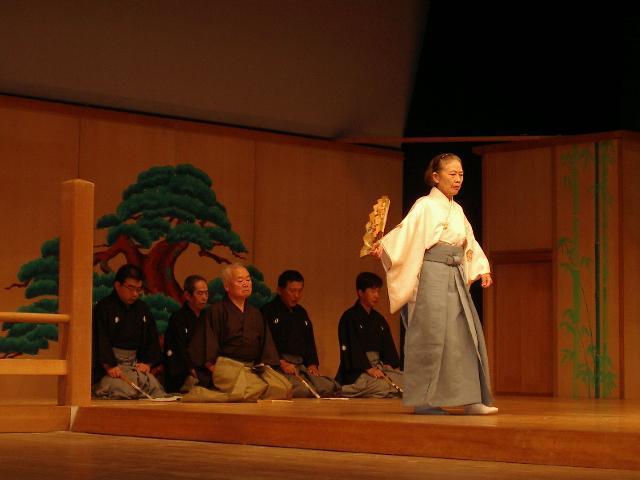
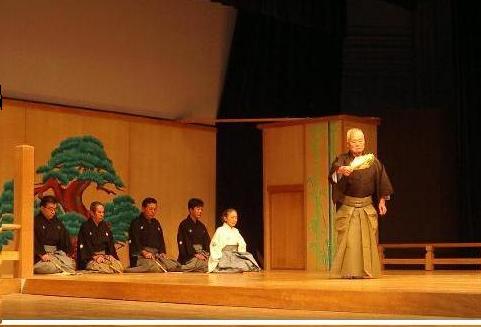
● 鶴ケ城薪能(第18回) 会津祭り協賛行事 終了しました。
日時 平成16年9月23日 17時30分開演
仕舞4番
松 風 渡部マサ子
地謡 小林 忠 長沼常哲 湯田真佐弘
鞍馬天狗 小野久子 河合政弘 庄條静雄
玉之段 宇田宣子 地謡 堀 篤子 五十嵐常子 玉川おくに子
敦盛クセ 和田保子 瓜生光子 石田セツ子 五十嵐久子
<火入式>
●能「西王母」 解説 岩沢和子
青山 伯 稲村忠兵衛
前シテ 古田豊子 ワ キ 岩淵健一 佐藤信英 中村寿男
後シテ 森田ルリ子 ワキヅレ大橋酉助 地謡 鈴木圭介 伊藤毅
子方 柳内優佳 舟木真一 佐藤昌一
能後見 松川善之助 丑米義弘 岸栄一郎 丸山一郎 小野木 保 伊東 正
装束方 丸山美伊子 佐藤ヨネ 小野木和子 岸栄一郎 森田ルリ子 ほか
●西王母
中国の古代神話に「君主がよい政治を行うと、西母王がご褒美として、三千年に一度実る桃をその君主に献上する」と言われている。
能のはじめに大屋台という作り物が舞台に運ばれ、王(ワキ役)と大臣(ワキヅレ)が舞台に登場し、地謡とともに情景を次のように説明します。
「いまだかってない賢い王の政治のため、国は平和で栄えている。これは大変喜ばしいことだ。眩くまでに輝く宮殿の四方には、諸侯や身分の低い人たちも集まっている。そして町は昼も夜も賑わっている」。
観客は質素なつくりの大道具を見ながら、きらびやかな大きな宮殿を想像し、臣下に囲まれている王をイメージしなければなりません。
そこへ、桃の枝を肩に載せた一人の若い女性(前シテ)が現れます。
「この枝は3000年に一度だけ、片方の枝に花が咲きそして実を結ぶ桃の枝です。今しも、この枝に花が咲いたのは、名君の善政の賜物です。私はあなたにこの枝を捧げたい」と彼女は言います。
彼は尋ねます。「それでは、この枝はあのSeiouboの園の桃ですか?」
彼女はそれには答えません。「実は、私は天国の人間で、Seiouboの分身です」と彼女は身分を明かします。そして、天国が不老不死の楽園であると語ります。やがて桃が実るだろうからその時は、桃を献上するために再び戻ると彼女は彼に約束し、姿を消します。
彼はこの出来事を大層めでたいことが起こる前兆として考えます。そして彼は宮中の楽人を集め楽器を鳴らし西王母の出現を待ちます。やがて、宮殿の庭に光が差すと、赤い錦を着て、腰に剣を下げ、冠をつけた美しいSeiouboが現れます。
彼女は侍女から桃を受け取り、それを帝王に献上します。これで、彼の不老長寿は約束されたことになります。喜びの酒宴において、彼女は着物の袖を翻し、美しく舞います。やがて鳥たちを伴い、彼女は静かに西の天に舞い上がり帰ってゆきます。
●The story of Seioubo
The source of this Noh story is of an ancient
Chinese myth. It is said that if a sovereign performs good politics,
heavenly Seioubo (the queen of western heaven) will give as a
prize a peach which will fruit only once in 3000 years, to the
king (sovereign).
Before the beginning of Noh play, an artificial product (stage
setting called the Ohyatai) is carried on to the stage and the
king (main supporting role in a Noh play) and a minister appear
on the stage. They explain a sight as follows with the chorus
singers.
"The country is prosperous in peace by the politics brought
from the new wise king we have never had before. We are very glad.
The feudal lords' army and the poor peoples have gathered to the
surroundings of the king's palace that shines dazzlingly.
As for the town, the day and night time are prosperous and crowded."
By looking at the stage setting of a simple
structure, a spectator has to imagine a gorgeous big royal palace
and the king who is surrounded by followers. A young woman (protagonist
of the first half) appears with the branch of a peach tree on
her shoulder .
"This branch is the peach on only one of the two branches
a flower blooms . Moreover, the tree bears a fruit only once in
3000years. A flower which bloomes on this branch indecates your
good politics" She says that she want to offer this branch
to him. He asks her. "Is this the peach of Seioubo's garden?"
She does not reply to it. She reveals a status "Really, I
am a heavenly human being, and I am the other self of Seioubo
" She also says that Heaven is an ageless paradise. as the
peach will soon fruit,she
promises to return again in order to give it to him. Then, she disappears.
He considers this affair as a sign from which a very auspicious
thing arises. He assembles the musician of the Imperial Court,
sounds a musical instrument, and waits for the appearance of Seioubo.
Soon, the light shines on the yard of the royal palace. Then,
beautiful Seioubo who attaches the crown appears. She wears the
clothes of red Nishiki , and carries a sword lowered to the waist.
From a female maid, she receives the peach and offers it to him.
This means that his perpetual youth and longevity are now promised
. In the feast she dances gracefully with fluttering the sleeve
of her kimono. She soars and returns to western heavens calmly
with some birds
能「西王母」
●春の演能 5月30日(日)
能 「田村」
前シテ 一条正夫 大鼓 舟木真一 星 英男 稲村忠兵衛
後シテ 佐藤ヨシカ 小鼓 折笠成美 地
佐藤信英 中村寿男
ワ キ 有我嘉雄 笛 角田久美子 鈴木直寿 平林光雄
ワキツレ 伊東 正 上野正義 佐藤昌一
後見 丑米義弘 小野木保 平山 昇
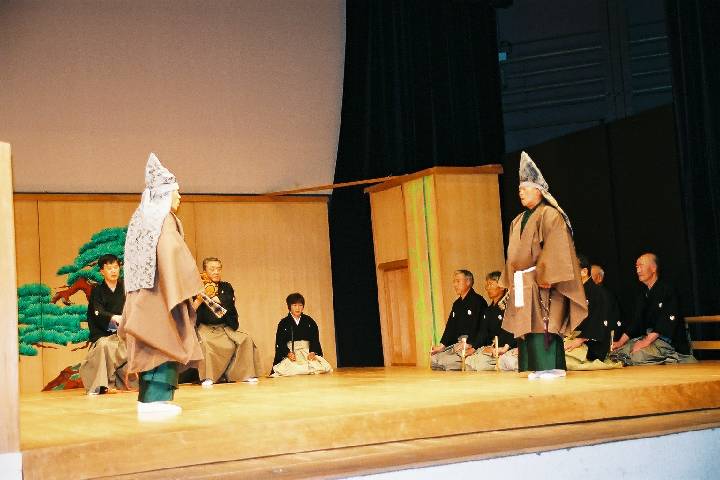
|
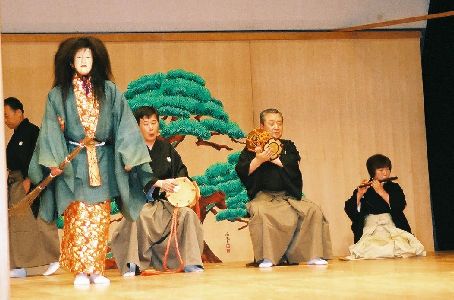
|
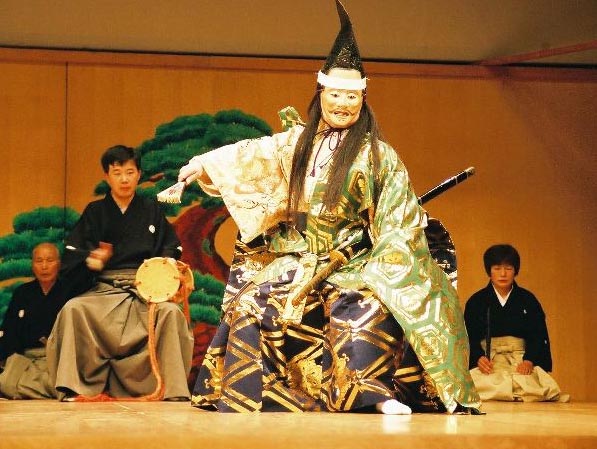
|
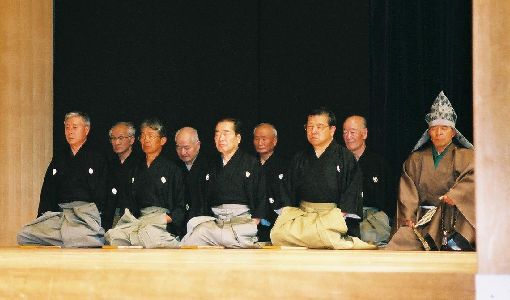
|
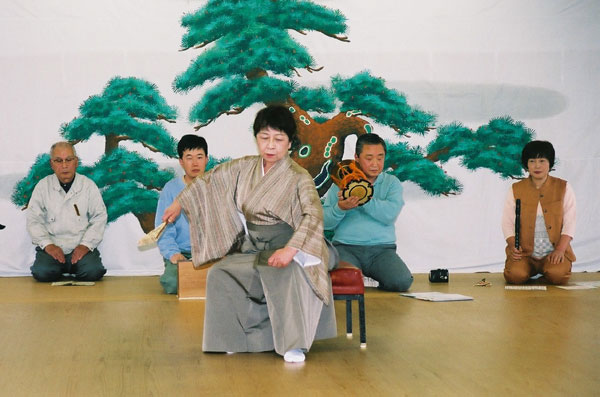
|
写真 上段左 ワキとワキヅレが都へ着いた 上段右 前シテの童子が箒を持ち登場する 中段 後シテ 馬上の坂上田村丸 右は地謡 の方 下段 申し合わせ(予行演習)の時の写真。上と同じ場面。 田村の男役を女性が始めて演じ、気合の入った舞台でした。 腰掛けているが馬に乗っている姿勢である。 |
弥生3月の半ば、東国から都に上った僧が花の清水寺に参詣すると、そこに箒を手にした少年(実は田村丸の霊)が現れる。僧が尋ねると、少年は清水寺の地主権現に仕える者だという。少年は僧の問いに、清水寺は大和の国小島寺の僧賢心が生身の観世音を拝むために坂上田村麻呂をスポンサーにして建立したという寺の来歴を語る。折りも折、日が暮れ、音羽の峰に美しい月が昇り、花を照らしあたりの景色を浮かび上がらせた。少年は名所を一つずつ指差し僧に教え、田村堂の内陣に入っていく.(中入り)
僧が夜もすがら読経をしていると、坂上田村麻呂の霊が武人の姿で現れ、かって、鈴鹿山の凶賊と戦ったありさまを舞って見せ、凶賊を平定できたのは、観世音の佛力によるものだと語って曲を終える。
● Tamura
It is in the middle of March.
A priest from an eastern country arrives in capital Kyoto. He
goes to Kiyomizutera temple, where cherry blossoms are in full
bloom.
A boy (as a matter of fact,the spirit of Tamuramaru ) with a broom
in his hands sweeps the dust away under the shade of a cherry
tree.
The priest feels strange and asks the boy if he is a watchman
of flowers?
The boy says that he is not the watchman but a servant of God
here (Jisyugongen).
The priest asks the boy to teach him the history of this temple.
The history of the temple is as follow
A priest named Kensin from Yamato county had wanted to worship
living kanzeon (one of the Buddha,the Goddess of Mercy).
One day, Kensin saw strange light in the sky and went to that
direction.
There was one old man and he said to Kensin that a big temple
should be built here.
So, Kensin asked Sakanouetamuramaru(a famous general and a man
of power) for it and he built a temple here on Daidou 2 (807 A.D.).
It got dark, and the beautiful moon rose upon the peak of Mt Otowayama,
and the flowers were lighted, and beautiful landscape of the surroundings
came to the surface.
He tells the priest about each beautifull spot by pointing, and
then he goes inside of Tamura temple.(intermisison)
When the priest is praying throughout a night ,Sakanouenotamuramaru
appears with the Samurai's costume.
Tamuramaru shows the appearance by dancing that he fought against
the bandit in Mt Suzuka.
He says" When I prayed to the Buddha(Goddess of Mercy )of
this temple for my victory, the Buddha gave a smile to me, and
I was encouraged.Therefore, I believe that I could subjugate them
by Buddha's power"
能 「藤」 Fuji あらすじ
前シテ 瓜生光子 大鼓 坂内庄一 堀 篤子 石田セツ子
後シテ 馬場律子 小鼓 阿部晃司 地 古田豊子 玉川おくに
ワ キ 松尾幸生 太鼓 佐藤ヨシカ 金川照子 五十嵐常子
ワキヅレ 舟木真一 笛 山田和彦
山田ミヤ子 志波幸世
後 見 松川善之助 岸栄一郎 丸山一郎
装束方 丸山美伊子 佐藤ヨネ 小野木和子 岸栄一郎 森田ルリ子ほか
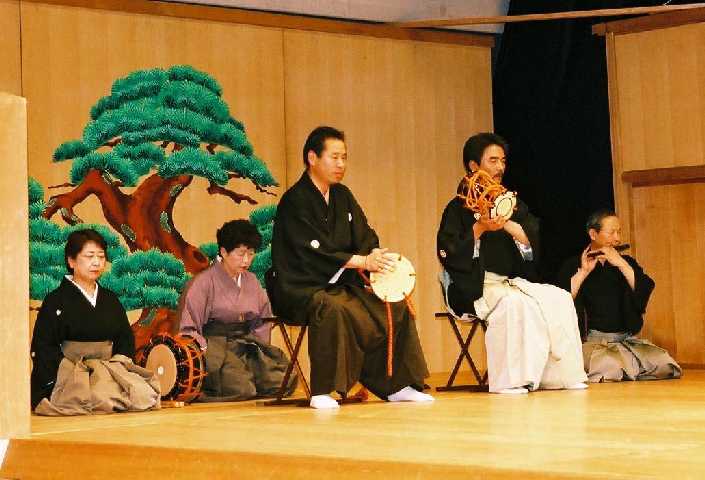
|
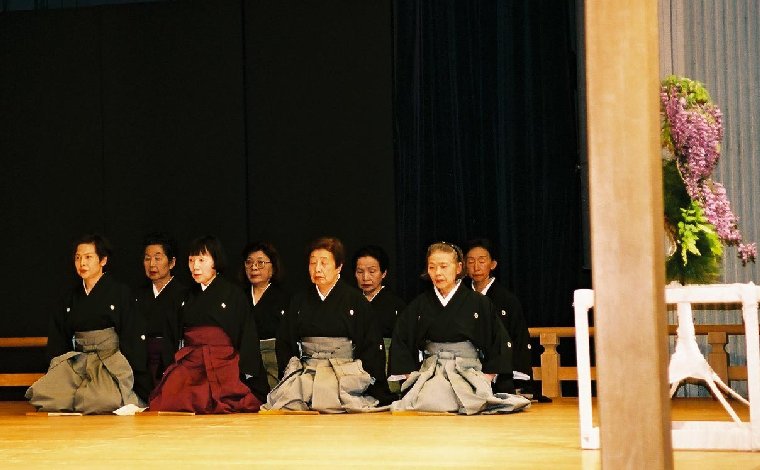
|
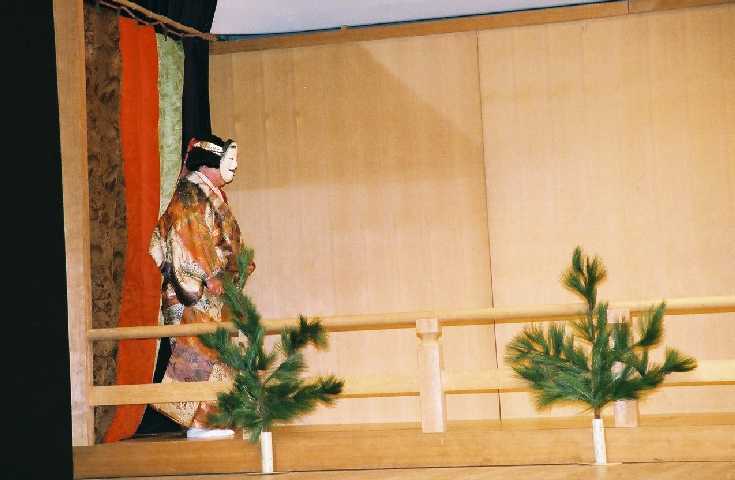
|
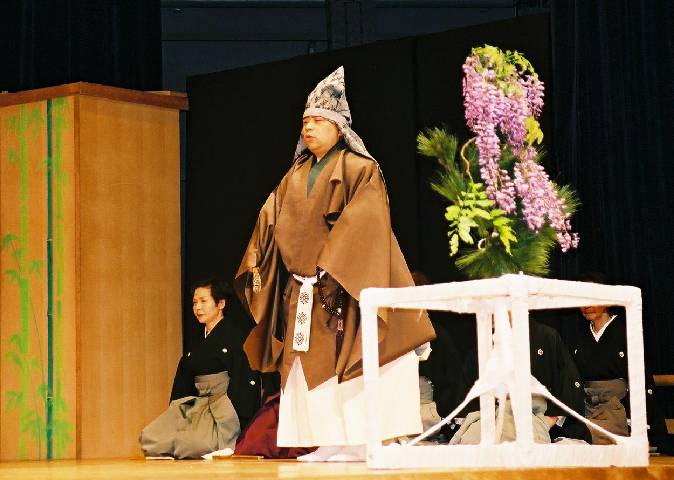
|
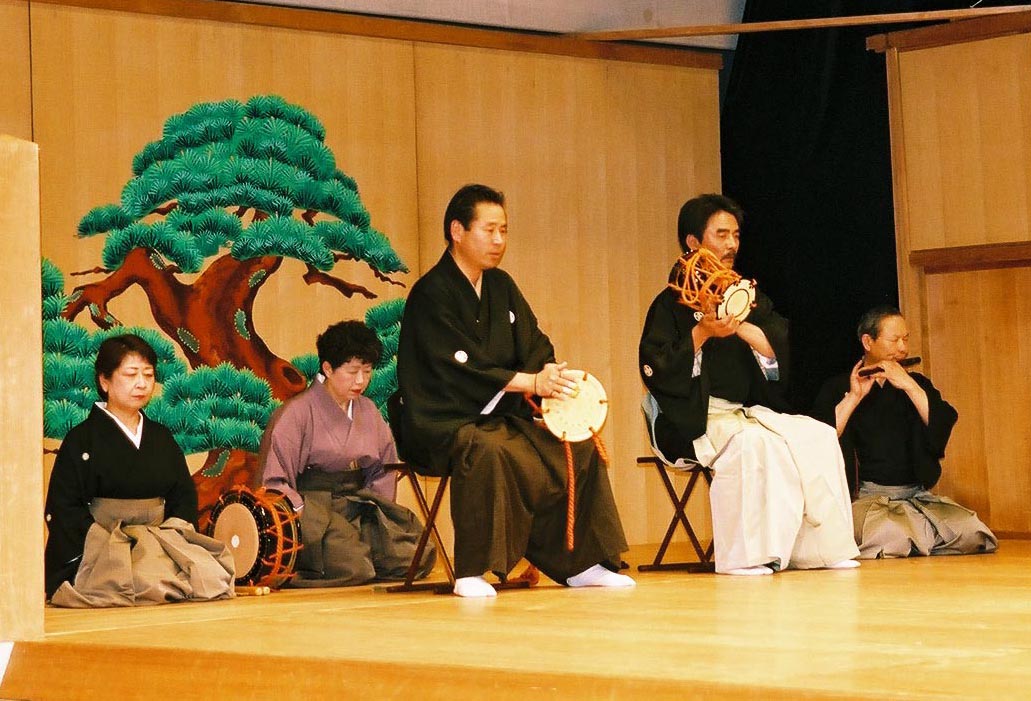
|
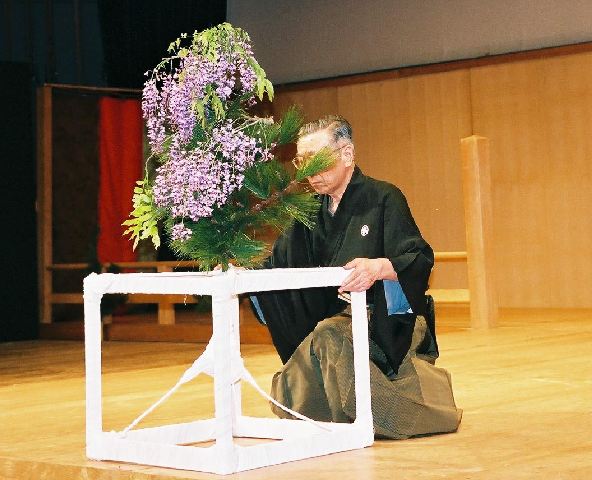
|
都からきた僧が北国をめぐり 、信濃の国善光寺に参詣する途上、越中の国多枯の浦を通りかかる。僧は折りしも今を盛りと咲きにほう藤の花を愛で,古歌「常磐なる松の名たてにあやなくもかかれる藤の咲きて散るやと」と口ずさむ。そこにどこからともなく美しい女が現れ、この地は藤の名所だが、どうして古歌「多枯の浦や汀の藤の咲きしより波の花さえ色に出でつつ」を詠じないのかとうらめし顔に言葉をかける。僧は女と歌についての問答をし、女の素性を尋ねると、女は藤の花の精であると答え、姿を消す。(中入り)
僧が仮寝をしていると、再び花の精が衣装を変えて現われる。花の精の身でありながら、仏法を行う問い尊い僧と言葉を交わせるのは「異性化身」・「自在不滅」ノ縁によるものだと喜びの心を述べ、美しい舞を見せ、夜が明ける頃,霞にまぎれて姿を消してゆく。
● Fuji (wisteria)
A priest of the capital city tours around the beautiful spot of
the northern country, and he goes to Zenkouji in Shinano country
(current Nagano Prefecture).
In the middle of the trip, he happens to pass by Tagonoura of
Ecchu country(current Toyama Prefecture)
The flowers of the wisteria are blooming there.
The priest recollects the old Waka which expressed about the transience
of those flowers, and he hums it.
'Why don't you recite the Waka which praised Tagonoura, the beauty
spot of the wisteria flower?"
The priest was impressed by her profound knowledge of Waka, and
he asks who she is. She says that she is a floral fairy of wisteria,
and she disappears. (Intermission).
While the priest is taking a nap, the floral fairy with her new
costume appears again.
She tells the priest.
" I can speak with you in spite of the floral fairy. That
is because I can change my figure freely by Buddha's power"
舞囃子「安宅」 シテ 大塚利衛
大鼓 佐藤りえ 五十嵐久子 星茂登美
小鼓 山田和彦 地 和田保子 浜崎幸子
笛 堀 篤子
宇田宣子 渡部妙子
舞囃子「鞍馬天狗」 シテ 平山 昇
大鼓 浜崎幸子 鈴木圭介 角田喜久雄
小鼓 山田和彦 地 渡部藤之丞 松川善之助
笛 石田桂子
皆川米作 岩淵健一
青山 伯 新井田幸喜
素謡7番 養老、三井寺,采女、清経、葵上、朝長、阿漕
仕舞7番 高砂、鶴亀,野宮、藤、梅枝、三輪、邯鄲